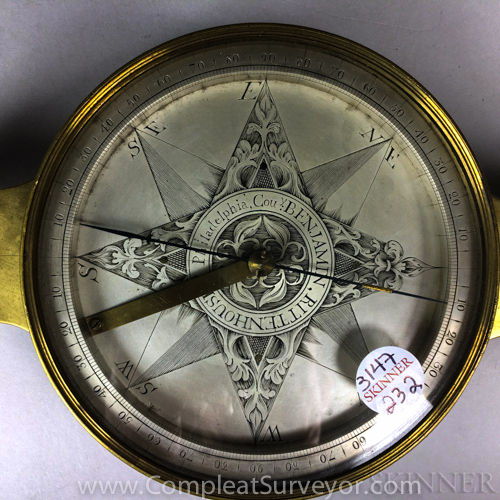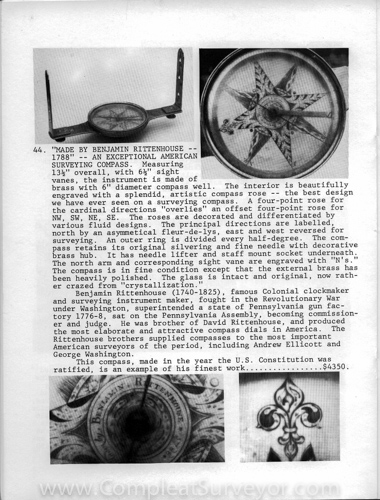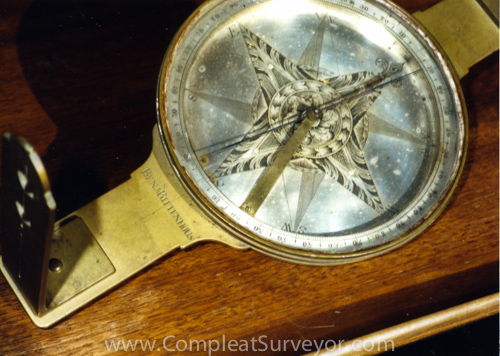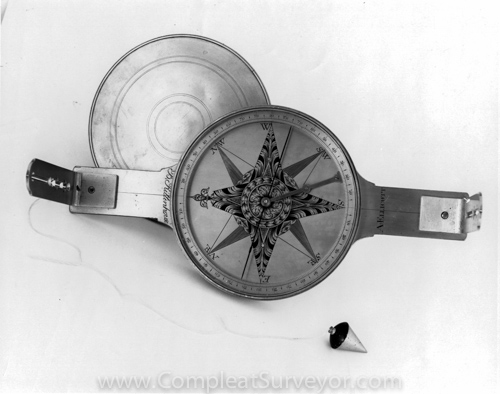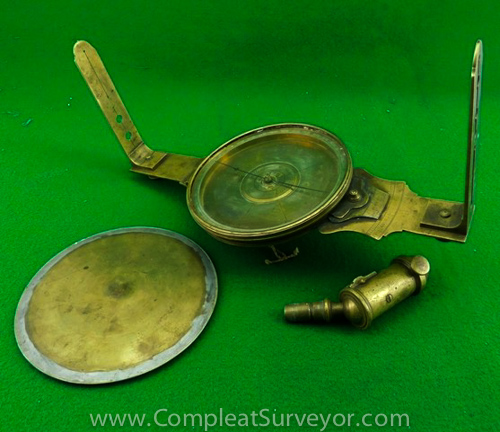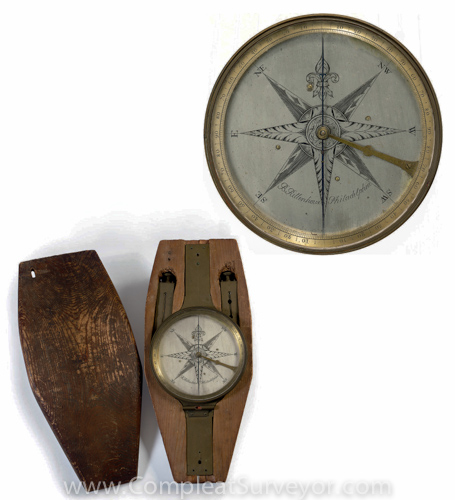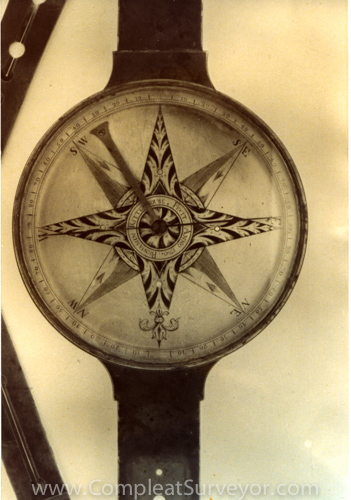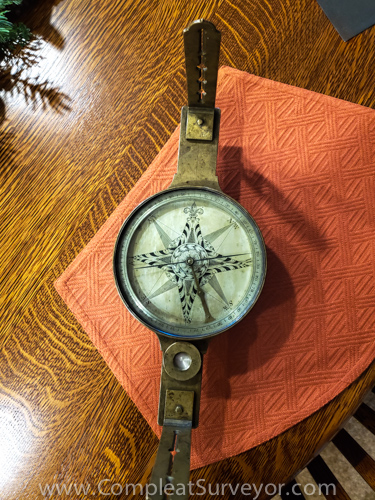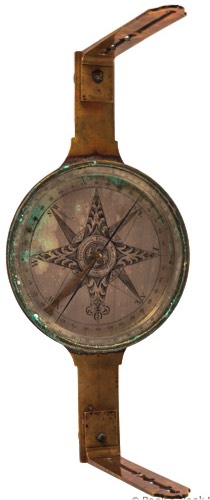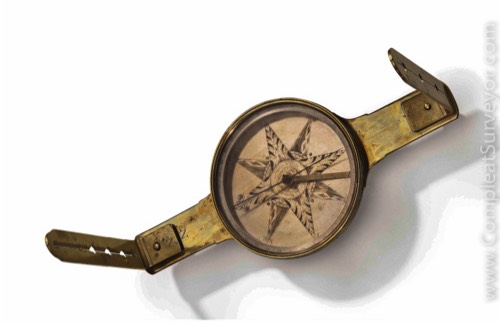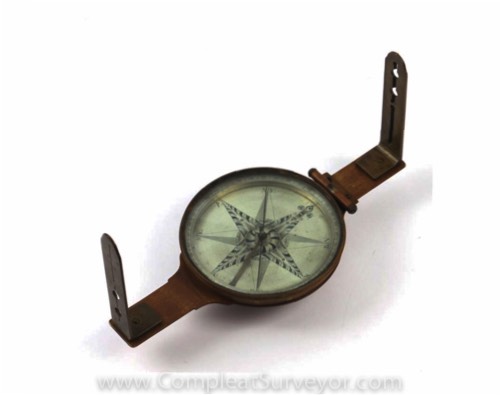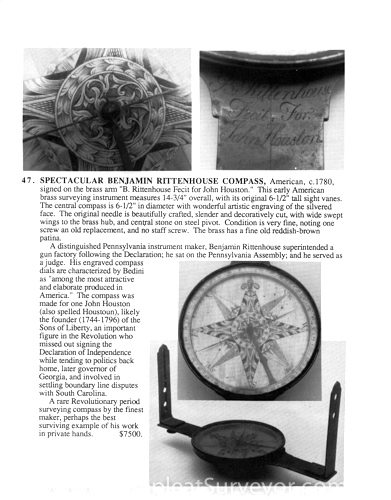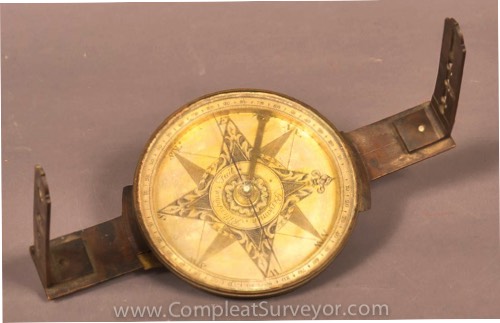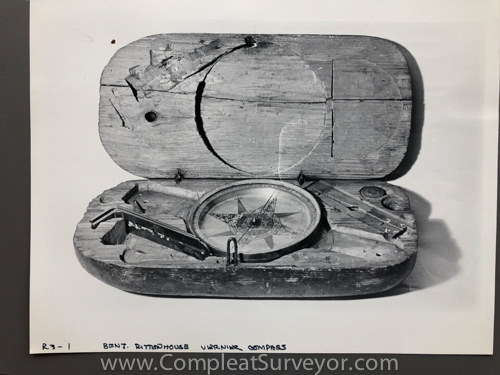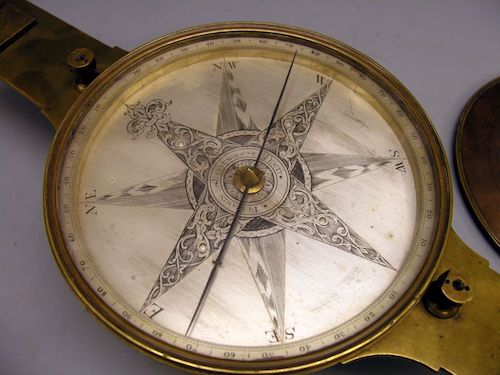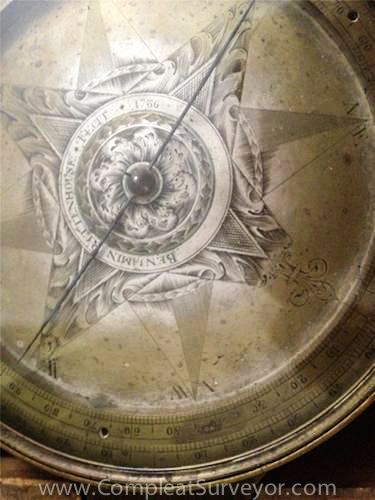Benjamin Rittenhouse
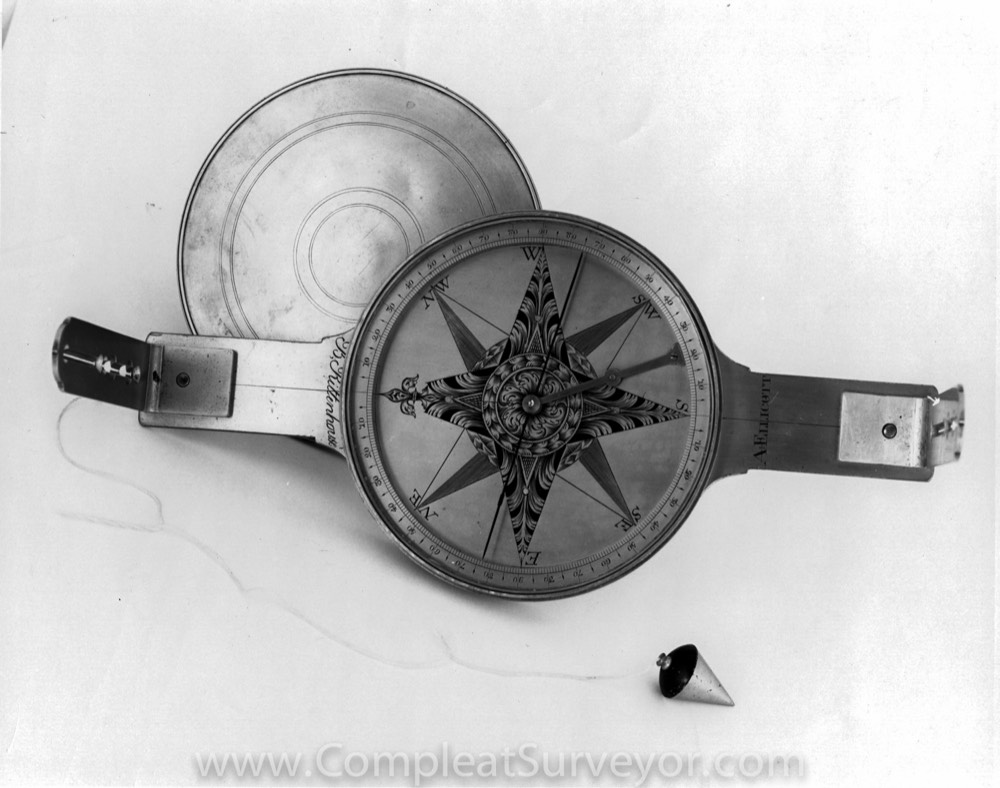
Benjamin Rittenhouse - Compass Made for Andrew Ellicott
Benjamin Rittenhouse - What We Know
Benjamin, the younger brother of David, was a master craftsman, and maker of fine compasses and clocks. Almost all known compasses by him are highly decorated works of art. His compasses were reported in 1798 to be the best available. Benjamin also held other important positions, both public and private. He was born in Norriton township about 1740, and died in Philadelphia in 1825.
Having an older brother interested in mathematical instruments and the sciences was influential upon Benjamin. David was responsible for the early training of his younger brother, and oversaw his apprenticeship (Barton, 1813, pp. 138). Probably while in his early twenties, Benjamin moved to Worcester Township. There he was primarily involved in making clocks, which involved machining with metals. This played a part in his being selected in 1776 to set up and run a factory to produce gun locks. They were made to supply the American forces in the Revolutionary War. He served as the superintendent of the factory until 1779.
After the war he returned home to Worcester and again began producing clocks and mathematical instruments. He also engaged in other activities. This included a position as head grain measurer in 1790, and Associate Judge of Montgomery County. He held the latter position for nearly ten years. He was also a member of the state Assembly. In addition, Rittenhouse worked at times as a surveyor. In 1789 he was on a project involving the Schuylkill River.
Some of Benjamin Rittenhouse's instruments and clocks are dated, others are not. The earliest Benjamin Rittenhouse compass marked with a date is 1786. He also made chronometers in that year.
By the Act of May 18, 1796, Congress authorized the survey and sale of lands northwest of the River Ohio. The Act specified that chains used in the survey were to be adjusted to a standard kept for that purpose. Benjamin Rittenhouse made the standard chain, and advised government officials it may be depended upon as accurate. It was sent to Surveyor General Rufus Putnam in 1797.
Both William Lukens Potts (1771-1854) and Benjamin Evans (1776-1836) started working with Benjamin Rittenhouse in about 1796. That is the year his brother David passed away. Potts was with Benjamin for about two years, then later worked independently. Evans, a nephew of the Rittenhouses, worked with Benjamin until 1801, the year of Benjamin's bankruptcy. Some compasses are signed "Rittenhouse and Potts," and some are signed "Rittenhouse and Evans." The year 1796 reportedly appears on a Rittenhouse and Evans compass.
Many of the compasses produced by Benjamin Rittenhouse had a nonius, or vernier. That innovation was so useful to surveyors, and the instruments so well made, that the Rittenhouse name came to be identified the vernier compass. While David was the first to develop the feature, it was Benjamin's compasses that brought the widespread recognition.
BR1 - VERY beautiful engraving. I don't know who owns this compass. My records indicate that the instrument was held by the PA Historical Society in 1927 - maybe the society still holds the instrument. The pic came from Jeff Lock's website.
BR2 - Another incredibly beautiful engraving performance by BR. Skinner Sale $2583. Price looks VERY cheap to me, but the sight vanes were apparently replacements, which probably impacted the selling price meaningfully. Nevertheless, this compass looks well-bought to me, as the engraving is wonderful.
BR3 - Dated 1788 Compass offered for sale by Tesseract for $4350 in the late 1980s. Looks beautiful.
BR4 - Wonderfully engraved compass complete with case. Click here for a write-up on the compass. Held by the Natural Museum of American History in Washington DC. The compass comes with a special staff adapter as well - the socket joint can be adjusted so that the compass is held rigidly in place.
BR5 - Very nicely engraved BR compass, with BR's signature not quite fitting on the compass. Very cool Privately owned in NY in 1990.
BR6 - Fantastic and historically important compass made by BR for Andrew Ellicott. Click here for a write-up on the compass. Held by the Natural Museum of American History in Washington DC.
BR7 - Another incredibly beautiful engraving performance by BR. Skinner Sale $4613 in 2018. Vernier compass made for John DeWitt in 1792. The Rittenhouse pioneered the use of vernier compasses, and but most of the surviving compasses are plain.
BR8 - This is a fascinating Vernier Compass made by BR. Very little engraving. I've read that BR might have cut back on his engraving efforts when he was going thru bankruptcy in 1801. Who knows if that's true. This came with the special Rittenhouse Adapter (see BR4 Description). Sold by the Meekers at $8750 or thereabouts.
BR9 - Another incredibly beautiful engraving performance by BR. Christie's Sale at $11,875 in 2010. A wonderfully clean and crisp compass.
BR10 - Dated 1790 Compass offered for sale by Tesseract for $4350 in the late 1980s. Looks beautiful. Formerly owned by the Gurley Museum.
BR11 - Beautifully engraved compass. Skinner Sale at $3075 in 2018. This compass has a circular level on it, likely a later add-on by William Young. That probably impacted the price somewhat.
BR12 - Dated 1790 Compass offered I found in Prices4Antiques. Looks very nicely engraved. Not the same compass as BR10 if you look closely, although they are both dated 1790.
BR13 - Beautifully engraved compass. This compass was privately owned in the Pacific Northwest in 1990, and the pics I have don't do the compass justice. Looks like a short in length compass however.
BR14 - Another beautiful engraving performance by BR. Christie's Sale at $10,000 in 2014. Interestingly, the vane and compass are are marked "N" on this example.
BR15 - Beautiful engraving. Butterscotch Auction Gallery Sale at $4400 (per Invaluable) in 2016.
BR16 - Gorgeous Compass offered for sale by Tesseract for $7500 in the late 1980s. Made by BR for John Houston. Looks like a fantastic compass.
BR17 - Beautiful engraving. Conestoga Auction Company Sale at $5500 (per LiveAuction) in 2017. Vernier Compass with a Jacobs Staff.
BR19 - Beautifully engraved and dated 1786 compass. Skinner Sale at $6150 in 2019. This is a special compass for two reasons. First, it is the earliest dated BR compass known. Second, it has an automatic needle lifter, which was likely based on the R2 compass, as discussed in my dad's article.
BR20 - Beautifully engraved BR compass that I pulled off Pinterest. Very interesting feature on both sides of the compass face - holders for something. I don't recall seeing those on a compass before. Any ideas what they are for?
BR21 - This is an OMG! type instrument. Note the 2 fully graduated rings. This was the Rittenhouses first version of a variation/vernier compass. The inner ring can rotate a full 360 degrees - which is way overkill I'm going to research this instrument further and then create a separate webpage for it.
Benjamin Rittenhouse Compasses - My Thoughts
Benjamin Rittenhouse Compasses are Eye-Candy.
While BR did not have DR's technical genius or creative skills, BR was a extremely talented engraver and instrument maker. And he had access to all of his brothers creative ideas. Small wonder that BR's compasses were prized possessions, and considered by many to set the standard for surveying compasses.
Nobody knows how many compasses BR made. No doubt he made quite a few, and hopefully more will surface in the future as well. Owning a BR compass is a bucket list item for many instrument collectors.
Rittenhouse Articles
Bud Uzes authored two articles in the early 1990s regarding Rittenhouse surveying instruments. Bud's files included a fair number of background reference materials, and I've found a few additional articles published in the last 20 years that are relevant to collecting surveying instruments made by the Rittenhouse Family. Attached below are the most helpful articles. Please keep in mind that collectors were trying to figure this stuff out, and that developments may have impacted some of the analysis and conclusions stated in the articles. I've also included a longer list of my dad's reference materials.
1. Uzes - Colonial Surveyor and Instrument Maker (1990) published in the Rittenhouse Journal (Vol 5, No 1).
2. Uzes - The Brothers Rittenhouse - 1994 ACSM Presentation (similar to the Rittenhouse Journal Article)
3. Bedini - David Rittenhouse (1732-1796) - Rittenhouse Journal (Vol 14, No 1).
4. Bedini - Benjamin Rittenhouse (1740-1825)
5. Bedini - Benjamin Rittenhouse and His Apprentices and Partners
6. Bedini - Relevant Pages from Thinkers and Tinkerers
7. Lock - David Rittenhouse Telescopic Theodolite - The American Surveyor (Dec 2007)
8. Forman - The Worcester Workshop of Benjamin Rittenhouse
9. Smart - The Makers of Surveying Instruments in America Since 1700 (Relevant Pages)
10. Other List of References Pulled Together by Bud Uzes
© 2020 Russ Uzes/Contact Me

